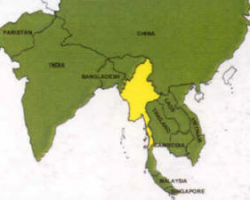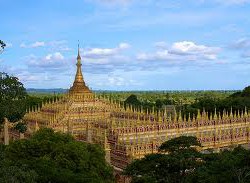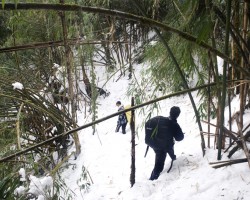As Asia at it best! Myanmar (formally known as Burma) has been isolated from rest of the world for some decades. It is now available today as one of the world newest destinations for the travelers. Myanmar offers great historical value, rich cultural heritage and a unique daily life style, Myanmar also possess a vast eco-diversity such as pollution free air, virgin landscape, lifespan river system and unspoiled beaches etc. To tell the absolute through what makes the destination most enjoyable is the Myanmar people who have often been described as the most friendly with happy faced and openhearted people in the world of Asia. Myanmar is a boundless land with 50 million people, home to the grater cultural diversity as many as 135 ethnic minorities who have lived in amity and weal of woe for thousands of years. In Myanmar there is still more magic and mysteries in the air than in any other its neighboring countries. The world richest and most impressive Buddhist monument, the Shwedagon, more than 5000 ancient Temples and stupas in 10 century archaeological Bagan, finest wooden architectures in Mandalay and unique lifestyle amidst Shan plateau, unspoiled white beaches or snow-capped mountains of the Himalayas in the extreme north are just to mention a few.
Physical geography
Myanmar is situated in the southeast of the continent of Asia, between N. Lat. 9° 31′ & 28° 31′ and E. long 92° 10′ & 101° 11′ with an approximate area of 676,577 esq. km [261,228 sq. miles]. It is an elongated piece of land 2,090 km [1,300 miles] long from north to south and 925 km [575 miles] at it’s widest from east to west. The total length of coastline starting from the southern tip of Bangladesh along the Bay of Bengal up to Victoria Point [Kawthaung] on the Andaman Sea is 2,832 km [1,760 miles]. The coasts and mountain barriers form natural frontiers with Bangladesh & India in the northwest, China in the northeast, Laos & Thailand in the east and southeast respectively.
Brief in historical background
Myanmar’s greatness in history dates back to the 11th century. There are strong factual evidences that many dynasties had reigned for centuries going back to the pre-Christian era. King Okkalapa who built the Shwedagon Pagoda during the lifetime of Buddha. The Vesali dynasty of Rakhine during the early Christian era. The Tagaung dynasty at Hanlin in the second century AD and the Pyu dynasty. There had been kingdoms at Srikshetra & Beikthano near Pyay, the Mon dynasty at Souvanabhumi [Thaton] & Bago.
 King Anawarahta consolidated the kingdoms and founded the First Myanmar Empire at Bagan in 1044 AD, extending up to the Menam Valley in Thailand. He established the Theravadas Buddhism. Progress with innovations in the cultural field of arts, dance, musical instruments, and masterpieces of architectural designs for the construction of religious edifices that we marvel today. Public utilities dams, roads and education etc. This dynasty reigned for over two centuries, when it was plundered and devastated by the Mongol hordes under Kublai Khan in the 13th century.
King Anawarahta consolidated the kingdoms and founded the First Myanmar Empire at Bagan in 1044 AD, extending up to the Menam Valley in Thailand. He established the Theravadas Buddhism. Progress with innovations in the cultural field of arts, dance, musical instruments, and masterpieces of architectural designs for the construction of religious edifices that we marvel today. Public utilities dams, roads and education etc. This dynasty reigned for over two centuries, when it was plundered and devastated by the Mongol hordes under Kublai Khan in the 13th century.
King Bayinnaung struggled to re-consolidate the kingdom in the 16th century and founded the Second Myanmar Empire [Hamsawady dynasty]. The Second Myanmar Empire stretched from the borders of India to parts of Thailand and Laos. The King built a new capital city called Hamsawady on what is now Bago. To the south of the Shwemawdaw Pagoda, the King had a grand palace, which named Kanbawzathadi. He reigned for 30 years. The Second Myanmar Empire collapsed in 1599 during the reign of King Nanda, his son and successor when King Bagyi of Rakhine and King Thihathu of Inca allied together and fought against him. Hence King Alaungplaya had to re-unify and founded the Last Myanmar Empire [Konebaung dynasty] in 1752. In the 133 years of reign, three Anglo-Myanmar Wars were fought in 1824, 1852 and 1885. Parts of the land were ceded and finally the whole country was annexed as a colony under the British. During the Second World War the Japanese Forces invaded and occupied Myanmar in1942 to mid 1945, when they were defeated to retreat. After two and a half years of re-occupation by the British, Myanmar gained independence as a sovereign state on 4th January 1948.
People & races
Myanmar comprises a family of eight major national races with as many as a hundred and thirty five ethnic minorities, distributed in the different regions of the country. The national races under the term Myanmar comprise Bamar, Chin, Kachin, Kayah, Kayin, Mon, Rakkhine and Shan races. Most of tribal groups still follow their own traditional customs, cultures, costumes, dialects and life-styles. Of the approximate population of 50 million.
Culture
Myanmar lies between two of the world’s great and ancient civilizations- China and India and it has incorporated the finer arts and blended it to the tastes of native traits and characteristics. Buddhism has great influence on the conduct of life, so the people have maintained the tradition of reverence for religion and clergy, obedience and respect for parents, elders & seniors. Simple and modest dresses and traditional native costumes of the different tribes. Every full moon day of the lunar month is celebrated joyously with delicacies, food and charities for a religious, social or seasonal festival. Lavish receptions for a happy or special occasion with music, merry-making, songs and dance. Generally speaking the people are hospitable, friendly and fun loving. But during the Buddhist Lent [from full moon of July to full moon of October] marriages and shifting of residences are a taboo for the laity. Also the change of monasteries for the clergy. Myanmar enjoys a rich heritage of culture and custom.
Religion
Theravada Buddhism is the predominant religion of the majority of the people. There is freedom of worship for all other religions and so, many followers of Christianity, Muslims, Hindus, other Sectarian beliefs including animists and Nat worshippers. All believers of their faiths live in harmony and peace.
Climate
Tropical rains and hot and humid but not torrid. Temperate and cooler in mountainous areas. Coolest period is from mid November till end of February with average temperatures 15-24°C. Hottest period is from March till end of May with average temperatures 25-33°C. Monsoon period is from June till October with average rain fall 15 inches and temperature 18-28 C.
Economy
Since 1988, the centrally planned economy was repealed with more liberal market oriented economy. Thus the private sector has been encouraged to do business in domestic & foreign trade and commerce. In keeping with the policy a number of laws had been promulgated. Agriculture, forest produce, minerals, oil, fisheries and tourism industry are the main sectors. Myanmar is making steady progress in rehabilitation by construction projects of dams, bridges, railways, roads, buildings, electricity and public utilities.
E-visa
September 17, 2014 Official Myanmar e-Visa
Ministry of Immigration has launched e-Visa on 1st September 2014. Only Tourist Visa is allowed and the citizens of 67 countries are eligible to apply e-Visa online.
Now the option to apply Pre-arranged Tourist Visa on Arrival through Ministry of Tourism ceased to exist and the travelers from countries outside of the 67 countries have to apply at the nearest Myanmar Embassy.
You may use your e-Visa to enter Myanmar through Yangon, Nay Pyi Taw and Mandalay International Airports even if you have chosen Yangon International Airport as port of entry.
On 17th September 2014, 43 countries are allowed to apply e-visa and on 2nd Oct another 24 countries have been added.
Citizens of Mexico are regretfully requested to contact nearest Myanmar Embassies to apply Visa to Myanmar for the time being.
List of 67 Countries
| 1. Australia | 23. Laos | 45. Austria |
| 2. Bangladesh | 24. Malaysia | 46. Bulgaria |
| 3. Belgium | 25. Nepal | 47. Chile |
| 4. Brazil | 26. Netherlands | 48. Colombia |
| 5. Brunei | 27. New Zealand | 49. Croatia |
| 6. Cambodia | 28. Norway | 50. Cyprus |
| 7. Canada | 29. Pakistan | 51. Estonia |
| 8. China | 30. Philippines | 52. Greece |
| 9. Czech Republic | 31. Poland | 53. Hungary |
| 10. Denmark | 32. Russian Federation | 54. Ireland |
| 11. Egypt | 33. Saudi Arabia | 55. Latvia |
| 12. Finland | 34. Serbia | 56. Lithuania |
| 13. France | 35. Singapore | 57. Luxembourg |
| 14. Germany | 36. Spain | 58. Malta |
| 15. India | 37. Srilanka | 59. Mongolia |
| 16. Indonesia | 38. Switzerland | 60. Panama |
| 17. Israel | 39. Thailand | 61. Peru |
| 18. Italy | 40. Turkey | 62. Portugal |
| 19. Japan | 41. United Kingdom | 63. Romania |
| 20. Korea, DPR | 42. United State of America | 64. Slovakia |
| 21. Korea, Republic | 43. Vietnam | 65. Slovenia |
| 22. Kuwait | 44. Argentina | 66. Sweden |
| 67. Venezuela |
Applicants are also asked to fill in your tour operator’s details if you are travelling with a group.
The single-entry e-Visa costs $50 (£30), will be stamped on arrival (it must be stamped within 90 days of the approval letter being issued) and is valid for 28 days.
Applicants will need to supply a color, passport-size photograph taken in the last three months and details of a return ticket.
An acknowledgment email with a reference code will be sent out afterwards and an approval letter should arrive by email within five days, according to the website. http://www.myanmarevisa.gov.mm
From 01 July 2015 Government allow E Visa from Myanmar- Thailand Border from the Entrance of Tachileik, Myawaddy, Hti Ki, Kawthaung border entrance.






